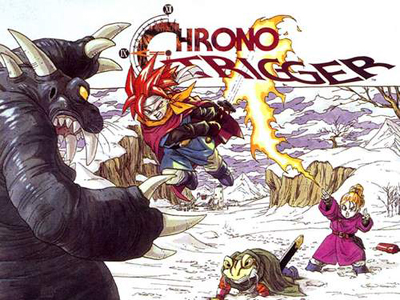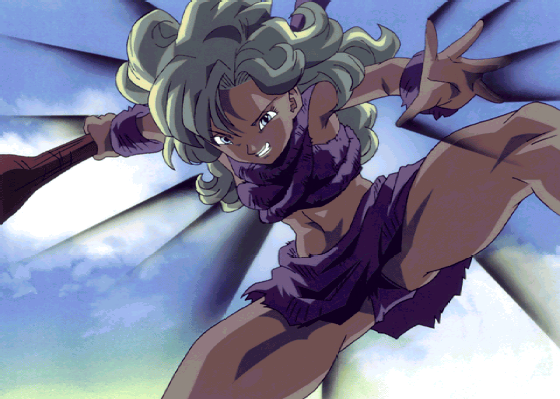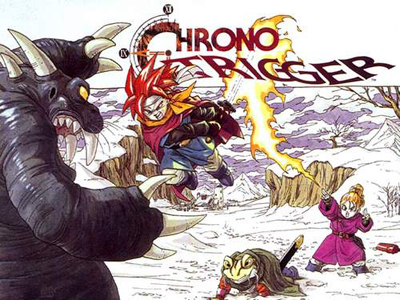 Box Art: note that this was one of the few RPGs whose cover art wasn’t given a Boris Vallejo-style makeover in order to "appeal to Americans." Also note that Marle, unlike in the actual game, and unlike 99% of all other female RPG characters, was actually dressed for the weather.
Box Art: note that this was one of the few RPGs whose cover art wasn’t given a Boris Vallejo-style makeover in order to "appeal to Americans." Also note that Marle, unlike in the actual game, and unlike 99% of all other female RPG characters, was actually dressed for the weather.
Original Release: 3-11-1995 (Japan), 8-22-1995 (US)
Publisher and developer: Square
WARNING: Big spoilers ahead!
Chrono Trigger came on the heels of the incredible success of Final Fantasy VI, hotly anticipated in both Japan and the United States. It was known as a "Dream Team" project, because it was a collaboration between the designers of Japan’s two biggest RPG series, Dragon Quest and Final Fantasy. Most of the core programming team was from Square. However, Dragon Quest designer Yuji Horii helped to write the story and provided supervision and guidance on the project alongside Final Fantasy creator Hironobu Sakaguchi, while the game was illustrated by Dragon Quest and Dragonball mangaka Akira Toriyama.
Chrono Trigger’s story was built around the mechanism of time travel; and it was the most ambitious time-travel game ever made at the time. Clear parallels can be drawn between CT and Ultima II, released more than a decade earlier, because of the two games’ use of similar themes and time periods. By design, Chrono Trigger’s story was light fare, closer in many ways to Dragon Quest than to the dark, serious Final Fantasy games. It poked gentle fun at nearly every RPG cliche out there, and shamelessly borrowed story elements from numerous Hollywood films.
In Chrono Trigger, Crono (the mute main hero, another Dragon Quest convention), is attending a festival in honor of the new millenium (1000 A.D.), where he literally bumps into a girl, who drops her necklace. Crono and the girl, Marle, become instant friends, play the games and sample foods at the fair… all of which will ultimately be used against Crono in a (kangaroo) court of law. They then witness the demonstration of a matter transport machine built by the local eccentric inventors Taban and Lucca, who is Crono’s best friend, and Marle offers to try it out, which of course turns out to be a big mistake. No, Marle doesn’t turn into a grotesque human fly, but her pendant somehow cranks the power output of the machine to the point where it goes from mere matter transport to being able to rip open holes in the space/time continuum. So Crono goes to rescue her, finding himself in the midst of the same great war whose victory was commemorated at the fair he just left! But this is just the beginning of Crono and friends’ adventures in time travel. Eventually, they discover that in another thousand years, the world will go through an apocalypse caused by the awakening of a long-dormant beast called Lavos. Crono and friends could easily follow the example of the nuclear power industry and think: "This isn’t our problem. Let the people alive then deal with it." Instead, the ragtag group of teens decides to take on Lavos and save the future of their world.
First, let’s look at the world of Chrono Trigger. It’s scaled down considerably from the huge world in FFVI, but this world covers a span of 65,002,300 years, and the actions taken in early time periods can, of course, affect events that occur in later time periods.
1000 A.D. – Crono’s home time period, where he lives in Truce, in the kingdom of Guardia, with his mother and hangs around with Arale, er, Lucca, daughter of the local crackpot inventor Taban. Guardia has been at peace for centuries following a horrific war between humans and a tribe of mystics led by a sorceror named Magus. Crono and Lucca are first drawn into the time travelling saga when Crono meets Marle – the disguised Princess Nadia of Guardia, who has run away from the castle – and she disappears during aforementioned transport accident.
600 A.D., The Middle Ages – This world still looks much the same as Crono’s, except that it’s still embroiled in that bitter war between Guardia and Magus. Crono’s heroic rescue of Queen Leene, the ancestress of Marle, who must be rescued or Marle will cease to exist due to the alteration of history – Great Scott, Marty! – endears him to the Guardia royal family of the Middle Ages, which contrasts to the shabby treatment he experiences at the hands of the royals in his own time, where he’s wanted for kidnapping Princess Nadia (Marle) and eating some jerk’s lunch. Ultimately, the party meets up with Guardia’s most respected warrior, Frog, who is indeed a giant man-frog, and manages to defeat Magus and his Monsters of Rock and Roll henchmen, Ozzie, Flea, and Slash.
2300 A.D. – The Bleak Future – In this time period, human civilization lies in ruins, the world is mostly devoid of life except for mutants and biker gangs, and the few surviving pockets of humanity are facing extinction. It is here that the party meets Robo, a friendly battle ‘droid repaired by Lucca, and discovers the "Y2K bug" that brought the world to this sad state: an interstellar parasite known as Lavos, which has laid dormant within the earth for millions of years, draining it of its life before laying waste to the surface world in 1999 and leaving to find another planet to leech. Even though Crono and his friends could all live happy, full lives without worrying about Lavos, since the Day of Lavos is so far in the future to them, they decide they have an obligation to stop Lavos. Ooooh-kay…
65,000,000 B.C. – "Father, I have sinned. I have drawn dinosaurs and hominids together in the same cartoon." – Gary Larson, The Far Side 10th Anniversary Exhibit. The prehistoric time period features every trope of prehistory popularized in The Flintstones and Jurassic Park. A tribe of Neanderthals led by a beautiful blonde Cro-Magnon woman named Ayla, is battling for supremacy over a world made of one huge Pangaea jungle continent with a race of technologically advanced dinosaur people. Thanks to Crono and crew, the humans win… just in time to witness the catastrophic Chicxulub meteor impact heralding the Cretaceous mass extinction and the beginning of the Great Ice Age… and it turns out, this "meteor" is none other than the larval form of Lavos.
12,000 B.C. – The Earth is still firmly in the grip of the ice age started by Lavos’ collision with the planet. A civilization far more technologically advanced than any that has come before or since has grown, under the guidance of Queen Zeal and the three Magi, Balthazzar, Gaspar, and Melchior, whom the party also meets at various other points in history. It is from this time period that the relics of ancient technology seen in later periods originated, as well as the Three Wise Men, the sinister Ocean Palace which draws its energy from Lavos to dominate the world, and a young, timid boy named Janus, who will eventually grow up to become the feared menace of the Middle Ages, Magus. The Zeal Civilization floats in the sky and enjoys the bounty of the land, while the people who dwell on the surface scratch out a bare existence from the frigid land, suffering from the double yoke of poverty and incursions from Zeal slavers. This time period was perhaps inspired by the myth of the ancient lost continent of Atlantis, and its concept of a technologically advanced sky-based civilization oppressing poverty-stricken surface dwellers would, two years later, be expanded upon and would become the core concept of a later Square masterpiece – Xenogears.
The End of Time: This area serves as the party’s base. Any time period can be accessed here, including the battle with Lavos. Reserve party members will stay here with Balthazzar. In addition, the party members can receive magic from a slightly goofy, yet powerful, wizard named Spekkio. It is also here that the party will acquire the time-travelling vehicle built by Gaspar, the Epoch.
During the first half of the game, Chrono Trigger plays out in a linear fashion, much like Final Fantasy VI does. Once the party obtains the ability to freely fly the Epoch about, the game can be pursued in any way you wish. Your party, however, can attack Lavos from very early on in the story. But there are many paths to Lavos, and the game is one of those rare games which features multiple endings, depending on the path you take to Lavos and which sidequests you’ve completed or not completed. Most of these sidequests yield powerful weapons as well as closure to a character’s personal story; and many of them are based on the concept that actions taken in an earlier time period will affect later eras – for instance, you can set Robo, who has a virtually limitless lifespan, to farm and plant the barren desert in 600 A.D., after which you will find that a lush forest has replaced the same desert in 1000 A.D. Fortunately, Lucca can easily repair Robo’s worn-out husk.
CT’s cast of characters is quite likable, which explains much of its enduring appeal. Crono is a typical Akira Toriyama RPG hero: mute and spiky haired, although his hair and clothing are colored more like a Final Fantasy hero as opposed to Dragon Quest heroes, whose designs are all based upon Son Goku from the Dragonball manga and anime. Lucca, the bossy, slightly conceited female inventor who is the brains of the party, is clearly patterned after Arale, from Toriyama’s Dr. Slump; Lucca wears coke-bottle glasses that are popularly called "Arale glasses" in Japan. Frog is a parody of RPG heroes who live rigidly according to real or imagined codes of chivalry, such as Locke or Cecil; he is also driven by a desire for revenge against Magus, who transformed him into a frog after murdering Frog’s best friend, Cyrus. However, at a pivotal point, the party corners Magus in his native time period, 12,000 B.C., and has the choice of finishing him off or even forgiving him and allowing him to join the party! Marle, is of course, a parody of the "princess in distress" trope that’s been a part of countless RPGs and adventures since Super Mario Bros. My own personal favorite is Ayla, the beautiful, powerful blonde Cro-Magnon cavewoman who leads a tribe of Neanderthals, clearly modelled after the protagonist of the same name of Jean Auel’s 1980 best-selling novel The Clan of the Cave Bear, who is herself a Cro-Magnon woman living amongst a tribe of Neanderthals.

Many here at 1UP cite Chrono Trigger as the greatest RPG ever made. In my own opinion, it is indeed a great RPG, but it never captured my imagination the way Final Fantasy VI did. My last blog in this series should have made clear how I felt about FFVI, and as Kazekiri mentioned, that’s a nearly impossible act to follow. For me, CT just couldn’t outshine the blazing brilliance of Final Fantasy VI. It’s an enjoyable quest, but it lacks the sheer grandeur and epic storytelling of its more famous predecessor. Part of this was the fact that it was the intent of the designers to make CT a lighthearted parody of RPG character and story cliches, an RPG equivalent of Scary Moviie or Epic Movie. I appreciated the parody elements, and enjoyed the story overall. Although I appreciate grand epic tales, it’s not necessary for every RPG to strive to be Star Wars or Homer’s Odyssey. The multiple endings, however, were genuinely revolutionary, and are something that isn’t seen often, even today. There’s even an interesting sequence that plays if the party dies fighting Lavos, where you watch as the world’s civil defense agencies engage in a futile struggle to protect the populace from Lavos, ending with the apocalypse and the haunting words,"But the future refused to change." Sometimes it’s nice for a player to know that the world’s survival really rides on his success, instead of simply getting a "Game Over" screen every time.
I should also talk about the music as well. Yasunori Mitsuda is credited with CT’s soundtrack, with Nobuo Uematsu completing the soundtrack after stress-related illness forced Mitsuda to step down. Nevertheless, CT was the launching point for Mitsuda’s own career as an independent composer, and his finest soundtrack to date is that of Xenogears. Some of his pieces are quite haunting, many of them using sound effects simulating demented laughter and babies crying, as well as elements of FFVI’s haunting wind sound effect; most of these are connected with Magus and Zeal, including Magus’s castle theme, his battle theme, as well as the themes to the Zeal Palace and the Ocean Palace. In keeping with the lighter parts of much of the game, most of the music is lively and fast-paced, with a sense of fun.
Chrono Trigger remains so renowned partly because it did not spawn a long-running franchise. It had a sequel, Chrono Cross, which polarized CT fans between those who loved it and those who hated it and denied its very existence. Several other games have been claimed as spiritual successors for CT: Xenogears was the best known of these, featuring many of the thematic elements of the Zeal time period, such as the floating empire and the Three Wise Men, as well as a Lucca cameo in Lahan village, and a powerful score composed by Mitsuda, his best to date. More recently, Hironobu Sakaguchi, now president of Mistwalker, claims that the Blue Dragon series is the successor to CT, owing to its lighthearted tone and the fact that it is a collaboration between Sakaguchi and Akira Toriyama. As they say, "absence makes the heart grow fonder," and there has never been anything quite like Chrono Trigger, except the now-forgotten Ultima II which spawned it. Sometimes, that’s not a bad thing at all.
Thanks, as always, for reading, and be sure and tune in next time, when I’ll profile another "crossover" RPG"; this one between the sensibilities of Final Fantasy and those of a certain mustachioed hero with a taste for ‘shrooms….


